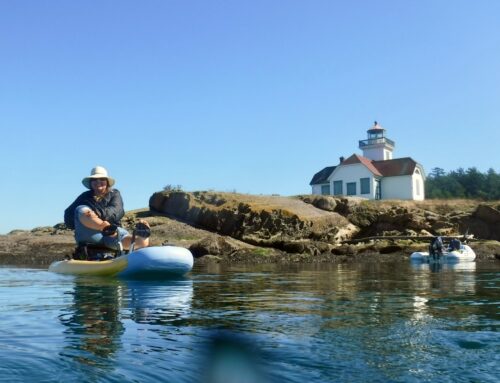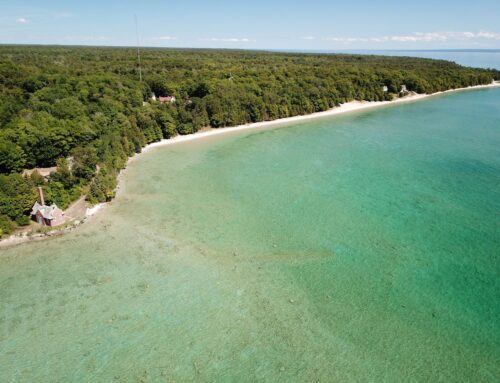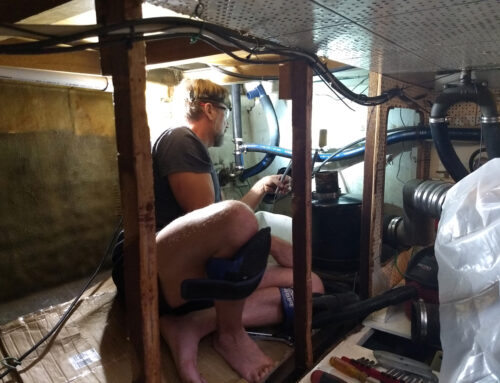 Note: This was the head on our previous boat, Webfoot, a MacGregor 26. While we no longer have a composting head we are happy to answer any questions, so feel free to send us an email.
Note: This was the head on our previous boat, Webfoot, a MacGregor 26. While we no longer have a composting head we are happy to answer any questions, so feel free to send us an email.
When we purchased Webfoot it came fully equipped with a used(!) porta-potty. Some of the parts were missing, so the blue liquid (also kindly included) would slosh out if the boat rocked too much. Luckily for us, the compartment that holds the “added” liquids was well sealed. Needless to say, the potty had to go. But now we were left with the question of what to replace it with. The male captain among us voted for using the back of the boat and simply using the head-room for storage. I would not hear of that. Sailing does not need to be uncivilized. So we debated getting another porta-potty, but after learning on our old boat that one has to walk to the pump-out station carrying the entire potty and then very ungracefully dump it into a hole covered in… you get the picture. This would not do.
Needless to say, the potty had to go. But now we were left with the question of what to replace it with. The male captain among us voted for using the back of the boat and simply using the head-room for storage. I would not hear of that. Sailing does not need to be uncivilized. So we debated getting another porta-potty, but after learning on our old boat that one has to walk to the pump-out station carrying the entire potty and then very ungracefully dump it into a hole covered in… you get the picture. This would not do.
We thought about a regular marine head, but after having worked and lived on many a boat with marine heads those were quickly vetoed due to limited space for a holding tank. Not to mention having to drive the boat to the aforementioned station and this time ungracefully pumping said refuse into a similar hole. If you’ve ever read Janna Cawrse Esarey ‘s book the Motion of the Ocean you would know what can happen during a routine pump-out. I don’t want to ruin it for you, but it’s not pretty. If you have a marine head or have been reading these blogs for some time you will know that there is an endless stream of maintenance issues and repairs involved with heads requiring many gloves and cleaning products.
 So after much research, we came across another alternative: The Composting Head. This nifty device separates the “solids” from the “liquids”. By doing so it allows the “solids” to become a healthy (usable) compost by composting it with a material such as COIR
So after much research, we came across another alternative: The Composting Head. This nifty device separates the “solids” from the “liquids”. By doing so it allows the “solids” to become a healthy (usable) compost by composting it with a material such as COIR. The liquids are stored in a semi-transparent bottle that can be safely transferred to a regular toilet in a grocery sack. Since the “liquid” is non-toxic it can also be safely disposed of in areas where it is legal, without any harm to the environment. The solids tank has to be emptied when it gets full – every few months depending on use. Best is to let the compost sit unused and let it finish composting but that is not always feasible. It can be emptied into a plastic garbage bag and tossed with regular trash (much like used diapers).
Speaking of being environmentally friendly: The average American uses 7,665 gallons of water per year just to flush the toilet. That is 21 gallons per day! So by installing a composting head we not only got rid of many unpleasant tasks, but we are also doing a small part in saving the earth!
By the way, if it’s working correctly, it doesn’t smell!
TECHNICAL NOTES
We have gotten a lot of questions regarding our Nature’s Head and I hope to answer some of them here. We purchased a Nature’s Head rather than the AirHead because we like the molded-in seat in the Nature’s Head – no seat to slide around in seas. We also thought the Nature’s Head just looked sturdier and it really is a very sturdy and well-built unit with all stainless parts. Remember, if it smells, something is wrong. We spent over a week in the San Juan Island and it started to smell towards the end. I’m fairly sure it was due to high moisture content and we should have added more composting material, which we hadn’t thought to bring along. For this season we have bought some enzymes (called DrainCare) to speed up the composting process. Since adding a dash of enzymes after each use and we have had absolutely no smells!
For composting material we use small bricks of coconut pith (COIR) available at your local hardware store or nursery. Since the bricks are very compact they are easy to store and much better than using peat since peat cannot be as sustainably harvested.
We installed the solar fan as well as the supplied fan, the latter seems to draw a lot more air and uses hardly any power at all. We could easily do without the solar fan.
The install was straight forward. We cut a 4″ hole into our head window to add a vent, removed the old potty and drilled two holes to secure the new head with supplied screws.
All in all, we spent around $1000 on the project and still think it was well worth it.
UPDATE 2018
We have now had two full-time boats with marine heads. Camille had a vacuflush head and Limerick has two Jabsco electric heads. While we thought the composting head is great for a weekend boat I can’t imagine having it on a full-time boat. I would rather empty the holding tank once a week than walk around with a bucket full of stinky pee every day.
The main reason I would not have a composting head on our liveaboard boats is that separating liquids and solids is easy enough for men (they can aim) but not so much for women. And what if you had eaten something bad?!
I’ll leave you with a photo of the aft head aboard Limerick which has a Jabsco electric head, as does the forward head. We recently replaced all the hoses and pumps and parts and now have a zero-smell system. To keep things clean, we use this amazing digestor in our toilets. Rather than try to mask the smell with marine deodorizers, this stuff liquifies sludge and neutralizes odors. And it doesn’t use any harmful chemicals.






Great information. I had no idea there were composting heads out there. I’ll have to check into this. Thanks.
Remove the top/seat part. Then just invert the base into a trash-bag. Most 13 gallon tall kitchen garbage bags will fit over the base. No need clean the interior of the solid waste container as composting will continue from the residual matter clinging to the sides.
To clean the residue from the liquids container add a 2 liter bottle of coke and let sit over night.
So glad I found your post (via Ceildyh’s blog.) We are installing our Nature’s Head this weekend.
Question for you. How do you empty the solids area when it gets full? The liquids area is straightforward, but not so sure about the back half.
Joe, We have found than when we use the Drain Care enzymes it all processes a lot faster. We just add a generous dash out of a spice shaker after using the solids tanks. We’ve been using it all summer and are still nowhere near full and have had NO smells! The liquids tank last 2-4 days for the two of us. Nature’s Head Composting Toilets are certified as Coast Guard Type III MSD devices and meet all “No Discharge” regulations.
The nature’s head website has lots more info: http://www.natureshead.net/marine.html
Send me an email if you want to know more. I’d be happy to answer any questions. Just go to my blogger profile and click on email.
What about solid disposal (process, frequency or number of uses, volume, etc.)? Also legality since I’m planning to cruise the Florida Keys this winter? This looks like a very cool alternative to what I’ve been considering. Thanks, Joe (Sailing the Judy B a 2001 Mac x)
Thanks for this link – I actually had read about this on your site before…its definitely something to consider, but with the very LOOOOONG list of things we have to do (and soooo little time), we’ll most likely just hook up a smaller tank (because that will be, more or less, turnkey)…but I really like this idea…perhaps we could install something like this later on?
Allan – Thanks for your comments. We’ve updated this post with some technical notes. Hope they help. Let me know if you have more questions.
LOVE the idea.
What make /modle did you use ?
Any concerns installing ?
Approx cost ?
I want to replace the aging potta potty on my 26 M
Thanks for the info